-
4
Threads -
8 GB
ECC Reg RAM -
100 GB
NVMe SSD Storage - 1 GBit/s connection
- Traffic included (fair use)
- Daily backup
Linux NVMe SSD vServer / VPS
Lightning fast vServers thanks to all-flash NVMe storage!
- ✓High Speed NVMe SSD Storage
- ✓KVM Virtualization
- ✓Fast Availability
- ✓Data Center Location Frankfurt am Main
Products
-
8
Threads -
16 GB
ECC Reg RAM -
200 GB
NVMe SSD Storage - 1 GBit/s connection
- Traffic included (fair use)
- Daily backup
-
12
Threads -
32 GB
ECC Reg RAM -
300 GB
NVMe SSD Storage - 1 GBit/s connection
- Traffic included (fair use)
- Daily backup
-
16
Threads -
48 GB
ECC Reg RAM -
400 GB
NVMe SSD Storage - 1 GBit/s connection
- Traffic included (fair use)
- Daily backup
Can't find the right package? Our Linux vServer overview will help you quickly find the right offer. For enterprise solutions, take a look at our Compute vServer or our highly available Ceph HA vServer. If you need even more performance, our dedicated servers may be just right for you. If you have any special requirements or questions, our support team will be happy to help!
Key Points at a Glance
Special features Linux NVMe SSD vServer
Our Linux NVMe SSD vServer products are based on hot-swappable U2/U3 NVMe datacenter SSDs. These provide a premium, high-performance hosting environment for your NVMe Linux vServer. The NVMe SSDs are operated in RAID level 10, which leads to an additional performance increase besides the already very high performance of NVMe SSDs.
Each Linux NVMe SSD vServer node is redundantly connected to the network and power within our data center environment in Frankfurt to realize maximum availability on the hardware side.
We provide our vServer customers with the most common Linux operating systems via 1-click installation. Equally, an installation of the Linux vServer is also possible with the help of an own ISO.
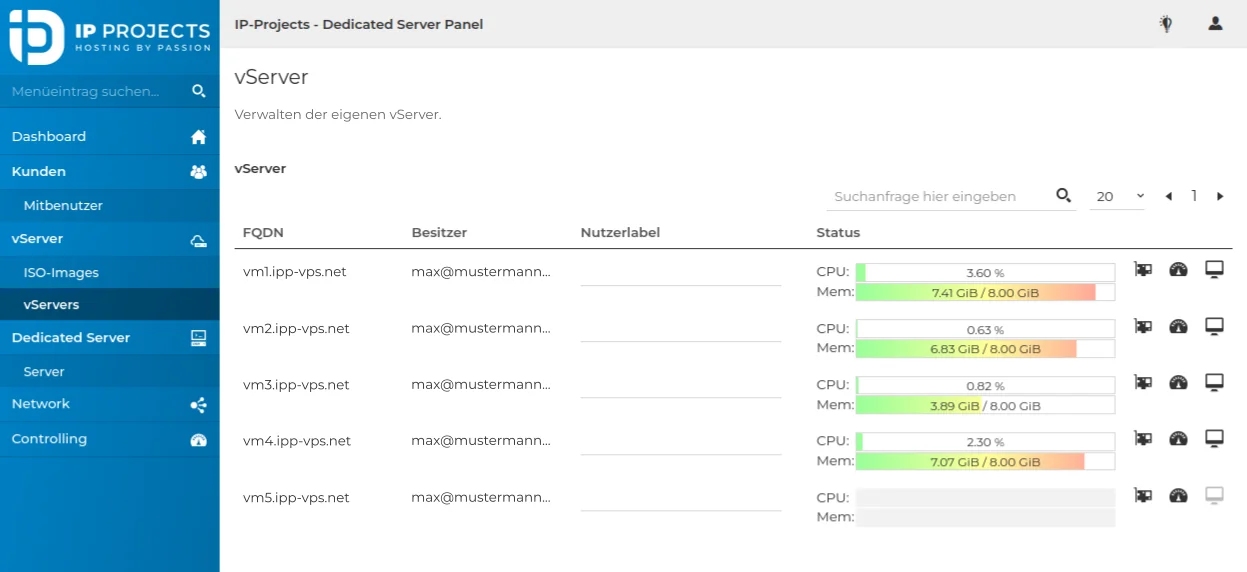
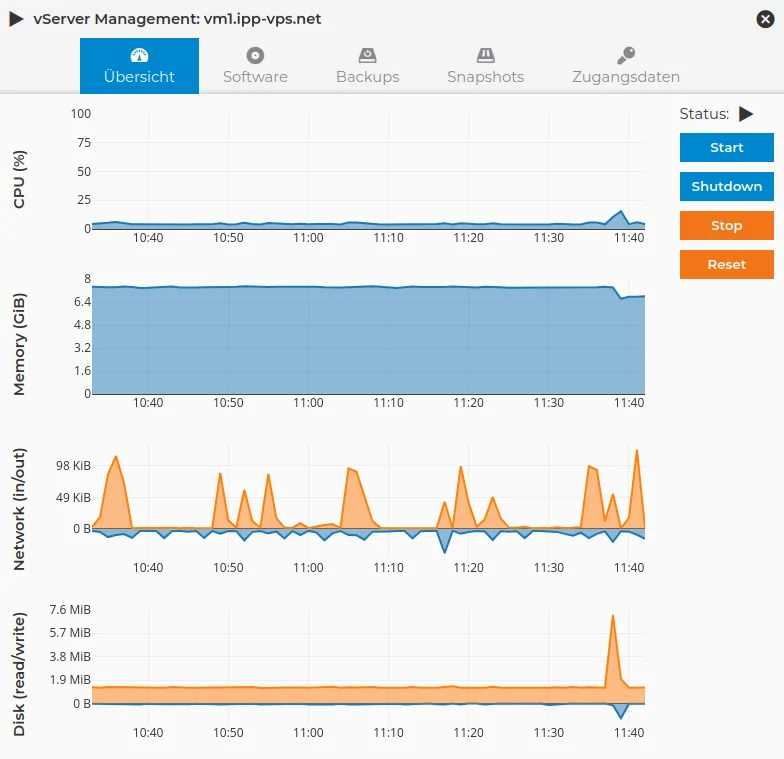
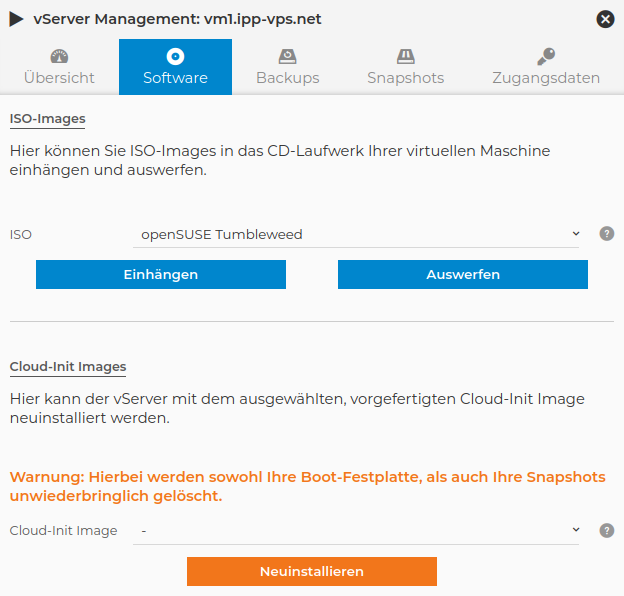
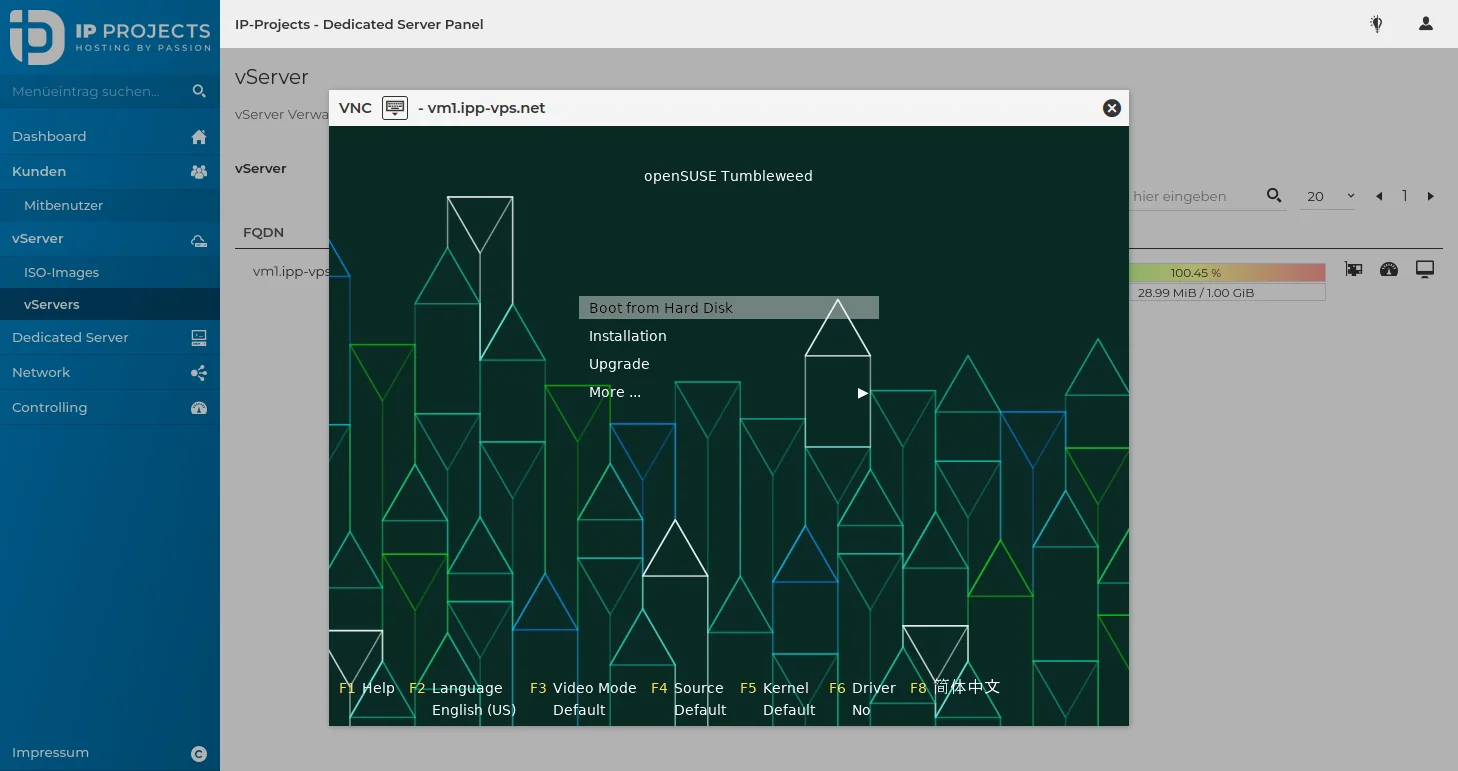
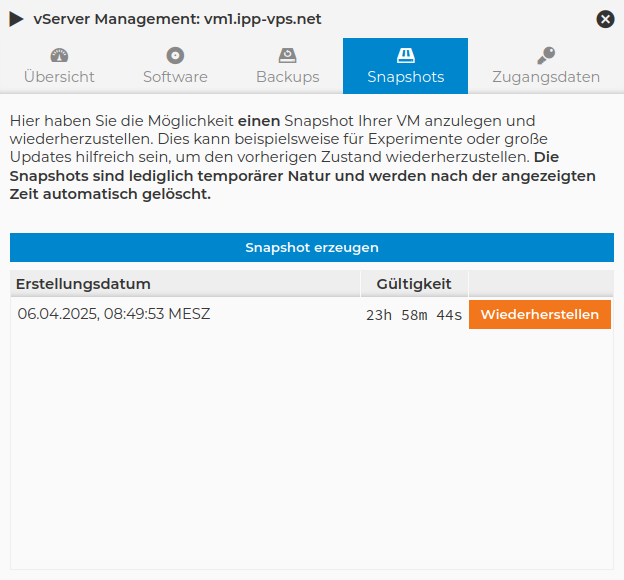
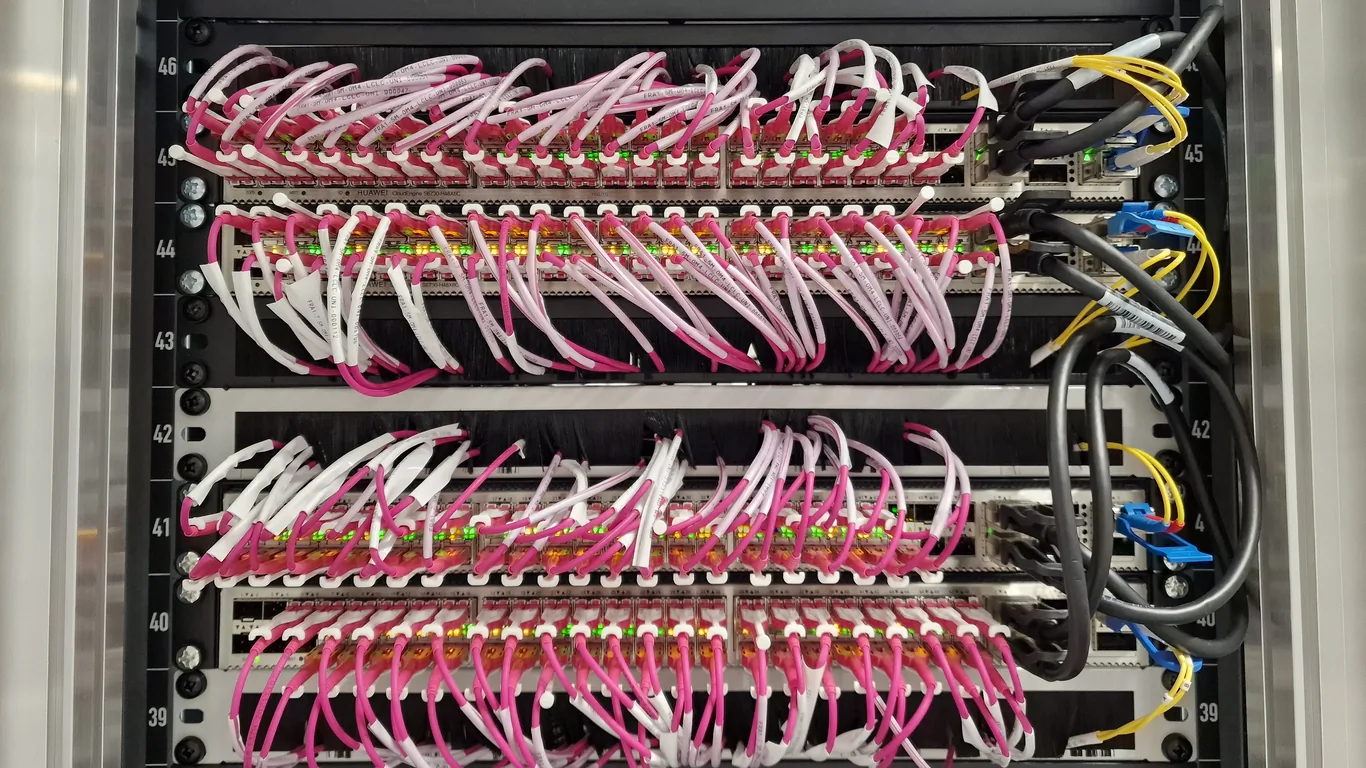
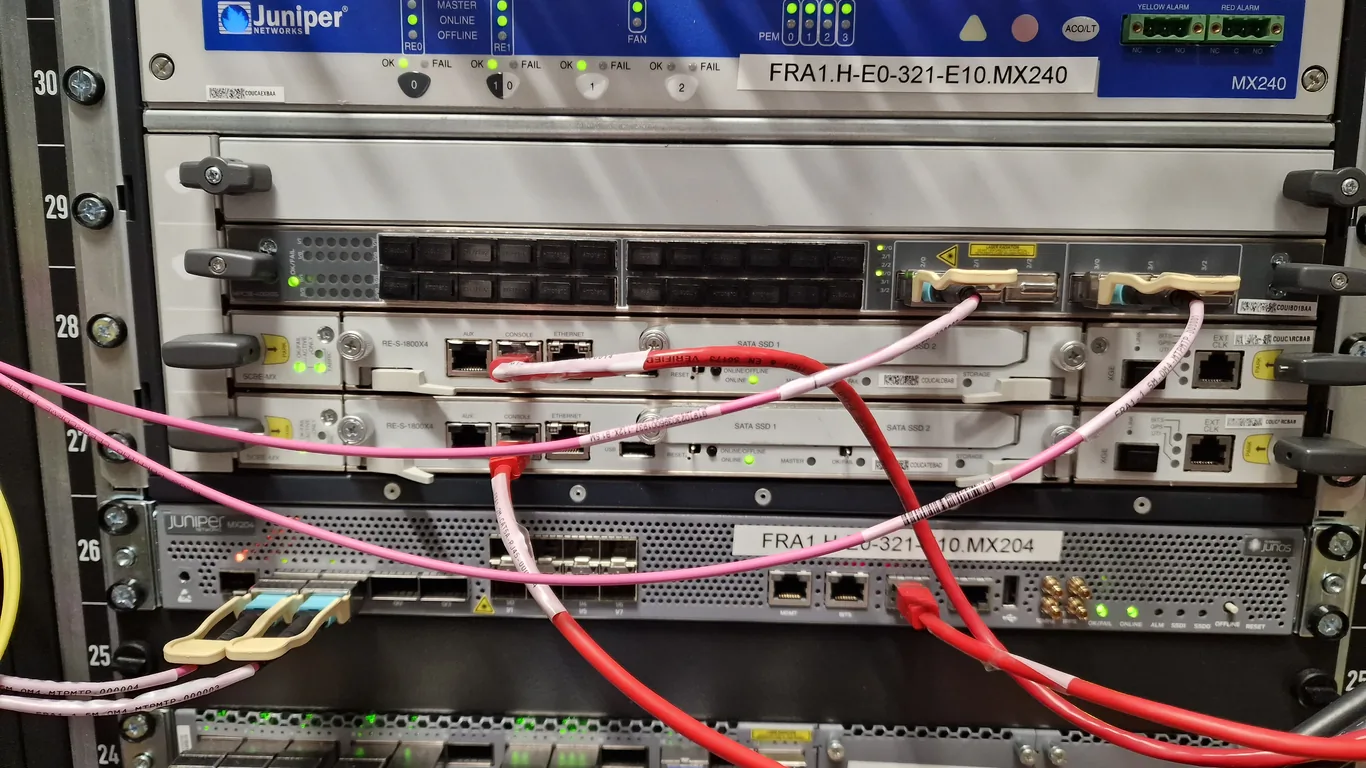

Easy vServer management: auto-installation, ISO mounts, IP/rDNS management, snapshots, backups, and much more!
The administration of our vServers is handled via our self-developed vServer management system. Installation, restarts, monitoring, IP management, and traffic analysis become effortless.
Through the individual dialogs, you always have direct access to the most important parameters and actions.
We offer all common operating systems for installation. Either as an automatic Cloud-Init installation. If we do not offer your desired operating system, ISO images can also be installed via VNC access.
Whether it's installation or troubleshooting. With VNC, you have direct access to your vServer at all times.
Snapshot and backup management is also simple and clear. This means you have everything under control, even if a problem arises.
Redundant core switch stacks for 10 Gigabit/s direct cabling - 80 Gigabit/s connection to routing stack - FRA1 location
Redundant routing stack consisting of technically different routers that are almost identical in terms of performance characteristics - Location FRA1
Server rack 0.8 x 1.2 meters with redundant top-of-rack switch stack and redundant 2-feed power supply - location FRA1
For more green IT
The carbon footprint of the Internet with its servers and data centers is growing incessantly. However, in addition to using energy-efficient hardware, we can also actively support nature: With every new rating - whether positive or negative - we therefore have 2 new trees planted.
Server Location Frankfurt am Main
Highest Hardware Redundancy
Fast Deployment
100% Green Power
Simple Server Management
KVM Virtualization
DDoS Protection
Upgrade Possible Anytime
Frequently asked questions
What are NVMe vServer offers?

Our NVMe vServers are virtual servers with a storage based on modern NVMe SSDs (Non-Volatile Memory Express). Compared to SATA SSDs or HDDs, NVMe offers a significantly higher data transfer rate and lower latency - ideal for applications with a focus on maximum IO/disk performance.
For which applications is an NVMe vServer suitable?

Our NVMe vServer products are particularly suitable for the following applications:
- High-performance web hosting / store systems (e.g. WooCommerce, Magento, Shopware)
- Database server (e.g. MySQL, PostgreSQL, MongoDB)
- Build and CI environments
- Game server with high disk activity
- Caching-Server (Redis, Varnish)
For which applications is an NVMe vServer suitable?

Our NVMe vServer products are particularly suitable for the following applications:
- High-performance web hosting / store systems (e.g. WooCommerce, Magento, Shopware)
- Database server (e.g. MySQL, PostgreSQL, MongoDB)
- Build and CI environments
- Game server with high disk activity
- Caching-Server (Redis, Varnish)
Is the data stored redundantly?

Yes - our NVMe vServers work with a ZFS RAID 10, which guarantees both high speed and a high degree of reliability. The NVMe vServers have local NVMe SSDs in U.2/U.3 format, which can be easily replaced during operation in the event of a problem. If you require even greater data security, a distributed file system, such as the one in our Ceph HA vServers, may be a sensible alternative.
Are there backup options for NVMe vServers?

Yes - the NVMe vServers are backed up daily incrementally to one of our other locations. In addition, it is also possible to have a longer backup retention period of 7 days for a small surcharge. In addition to incremental backups on the hypervisor side, we also offer the option of booking backup storage space on our external storage systems. These can be mounted within the vServer using SMBv3, for example. The storage devices are used exclusively for backups and should not be used as file storage.
Are there guaranteed IOPS or bandwidth limits?

In a shared vServer environment, it is always difficult to specify a guaranteed IOPS or bandwidth limit, as these are highly dependent on the performance of all other customers on an NVMe vServer host system. The NVMe vServers from IP-Projects have fixed storage thresholds and also allow these limits to be burst - exceeded - from time to time. A maximum write and read speed of 1,000 MB/s and 2,000 MB/s is available as a burst and a maximum IOPS of 500,000 IOPS for read requests with a burst of up to 800,000 IOPS and a maximum 100,000 IOPS for write requests with a burst of up to 150,000 IOPS. The limitation of the maximum IOPS and bandwidth performance ensures that a single NVMe vServer cannot fully utilize the total performance of a KVM hypervisor and thus always has sufficient performance available for other NVMe vServers.
Which NVMe hardware is used?

We only use enterprise NVMe SSDs from manufacturers such as Samsung, KIOXIA or Huawei. We rely on more than one manufacturer here to avoid potential firmware bugs, which in the past have often led to problems after a certain time.
Why is an NVMe vServer more expensive than an SSD server?

To enable NVMe SSDs to be replaced during operation, we use enclosures with a special NVMe SSD backplane for U.2/U.3. These enclosures are significantly more expensive in the initial server purchase than normal SATA/SAS enclosures. In addition, these NVMe SSDs always require an adapter/controller with HotSwap support. This makes them even more expensive, as most server motherboards do not yet provide such controllers onboard. The associated higher acquisition costs ensure that the NVMe vServer offers are more expensive than comparatively SSD/SAS SSD-based vServer offers.
Are there any set-up fees or minimum contract periods?

There is no setup fee for our NVMe vServer products. The minimum contract period is also very short at one month. Our mission is to convince through quality, service and performance and not to bind customers with long-term contracts.
Can I protect my vServer from DDoS attacks?

As with all of our (v)server products, DDoS protection is also available as an option for our NVMe vServers. This is available in various scales:
- Bronze DDoS Protection: Free of charge but without configuration options
- Silver DDoS Protection: DDoS protection according to predefined mitigation templates
- Gold DDoS Protection: DDoS protection including individual mitigation template
- Platinum DDoS Protection: DDoS protection including individual mitigation template and 24/7/365 technical support
Linux vServer operating systems
Linux NVMe SSD vServer Administration
NVMe vServer administration features
Of course, basic vServer administration functions are available with all our vServer products. These include:
- starting / stopping / restarting
- (re)installation
- VNC remote access
- stats like utilization and traffic
Following features are available with each of our vServer offerings:
NVMe vServer Backup Management
To always have a backup of your current data, each of our Linux NVMe vServers includes free backups of the last 24 hours.
The backups are also stored decentrally in a separate data center so that data loss due to a fire is impossible.
Linux NVMe SSD vServer Operating System Installation
The installation of our Linux NVMe vServer is possible as 1-click via our server management. Thereby all common Linux operating systems are available. If you still need a special Linux, you have the possibility of an ISO installation.
The ISO installation is then done with the help of a VNC console, which is directly integrated into our server management. An additional VNC client is not required to use this management function.
Permanent VNC Console
To ensure that you always have the ability to access the virtual machine regardless of the Linux NVMe vServer operating system, a permanent VNC console is available through our vServer administration panel. Therefore, if you make any misconfigurations - for example on the network - you can use this VNC console to undo the misconfiguration without the need for our customer support or restoring a backup.
The VNC console can be called directly from the web interface. An additional VNC client is not required, which makes working with VNC much easier at this point.
IP and R-DNS Management
Of course you can view your IP addresses and set R-DNS / PTR entries via our Linux NVMe vServer management. Setting R-DNS / PTR entries on an IP address is necessary to ensure smooth email traffic. Many e-mail servers on the Internet reject e-mails if no R-DNS / PTR entry is set for an IP address. Our name servers are also secured using DNSSEC to prevent manipulation of these entries by third parties. Likewise, all IP addresses that we provide to our customers are secured using RPKI.




